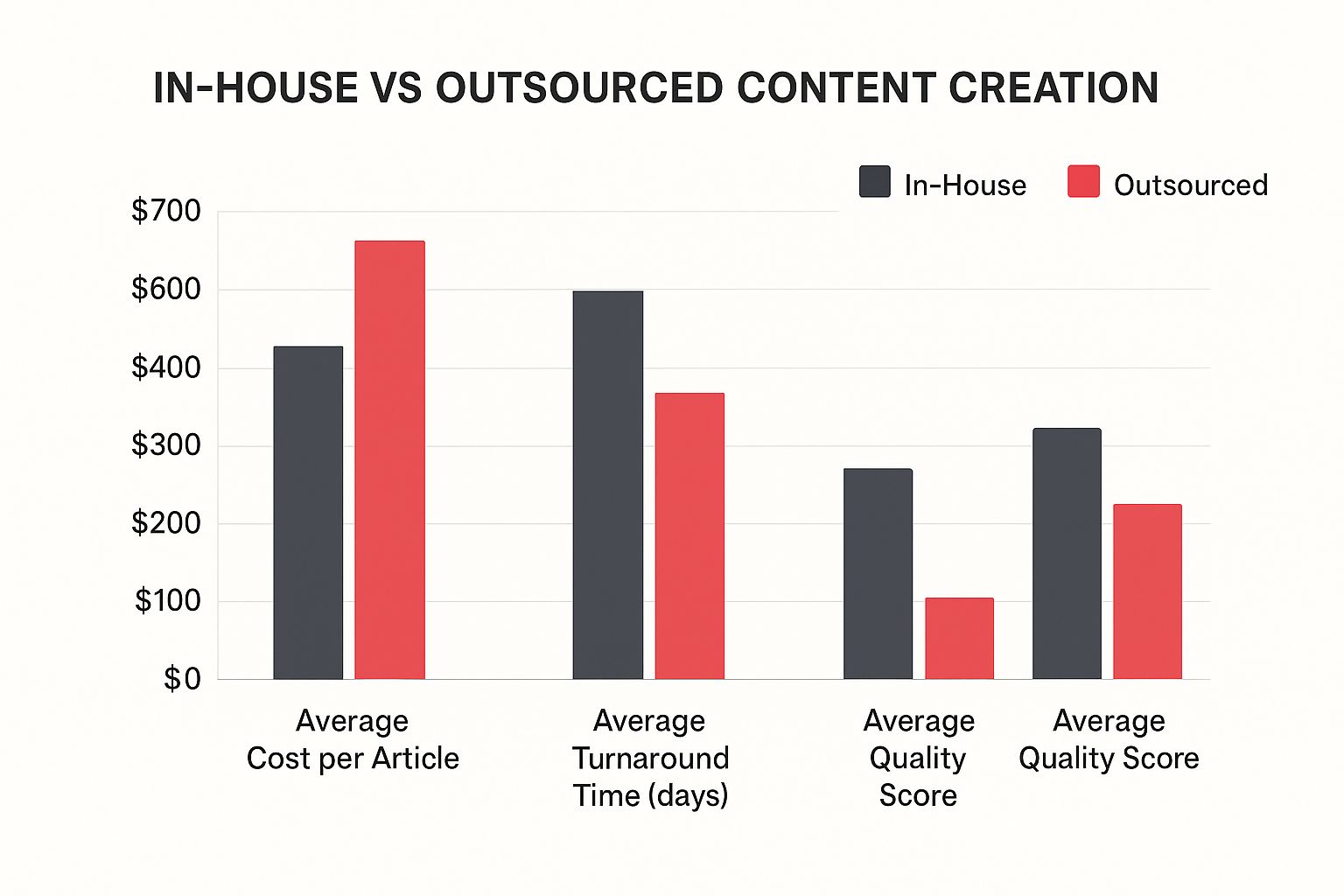Navigating Today's Content Outsourcing Landscape
The content world is constantly changing. Outsourcing content creation isn't just about hiring freelancers for occasional blog posts anymore. It's a dynamic ecosystem where businesses of all sizes tap into specialized external talent for a diverse range of content needs. This change is driven by the growing demand for high-quality, consistent content across many platforms. Think about the sheer volume needed to maintain an active presence on social media, blogs, email newsletters, and websites. It’s a lot, and many businesses turn to outside help.
Why Outsource Your Content Creation?
Several factors fuel the growth of content outsourcing. Businesses feel the pressure to maintain consistent publishing schedules while struggling to find and retain in-house experts across all necessary content formats. The cost of hiring and managing a full in-house content team can also be prohibitive, especially for smaller businesses and startups. This makes outsourcing an attractive alternative, offering access to a wider talent pool while streamlining budgets. You might find these blog articles helpful.
The Evolving Content Outsourcing Marketplace
Today's content outsourcing marketplace caters to diverse needs, from blog writing and video production to social media management and SEO optimization. Businesses can choose from a variety of outsourcing models:
- Specialized Agencies: These agencies focus on specific types of content or industries, offering specialized knowledge.
- Content Marketplaces: These platforms connect businesses with freelance writers and other content creators.
- Individual Freelancers: Hiring freelancers offers flexibility and cost-effectiveness for individual projects.
- Managed Services: These providers handle the entire content creation process, from strategy to execution.
The global marketing technology outsourcing market, including content creation services, was valued at $44.09 billion in 2023 and is projected to grow at 10.2% annually. This growth shows the increasing reliance on external expertise to manage complex marketing technologies, including AI-powered tools. You can learn more about these marketing technology outsourcing statistics. The future of content creation involves AI, which many outsourcing providers are beginning to integrate. Consider the implications when evaluating partners, especially with the increased use of tools that assist in writing with AI.
Content Outsourcing Growth by Region
The following data chart visualizes projected growth in different regions, reflecting the global nature of content outsourcing.

The chart highlights North America as currently holding the largest market share, indicating mature adoption of outsourcing in this region, while Asia Pacific shows the fastest growth. This growth is likely driven by factors such as cost-effectiveness and a large pool of skilled talent. Europe also shows strong growth, suggesting an increasing demand for these services.
To further break down regional growth, let's look at the data in a table format. The following table provides a comparison of content outsourcing market growth and projections across major geographic regions.
Content Outsourcing Growth by Region
| Region | Market Size (2023) | Projected Growth Rate | Key Outsourced Content Types |
|---|---|---|---|
| North America | $22.5 Billion | 8.5% | Blog posts, articles, social media content, video scripts, email marketing copy |
| Asia Pacific | $15 Billion | 12.1% | IT content, technical writing, e-learning materials, animation, graphic design |
| Europe | $6 Billion | 9.2% | Website copy, product descriptions, multilingual content, translations, subtitling |
This table summarizes the regional breakdown of the content outsourcing market. As you can see, while North America currently leads in market size, the Asia Pacific region is experiencing the most rapid growth. This information provides valuable insights for businesses considering outsourcing their content needs. By carefully analyzing these trends, companies can make informed decisions about where to find the best talent and resources for their content creation efforts.
The Real Business Impact of Outsourced Content

Outsourcing content creation is more than just delegating tasks. It's a strategic decision that directly affects your bottom line. It offers measurable benefits that go beyond freeing up your internal team, potentially transforming your entire content strategy. This means businesses can use outsourcing to achieve significant gains in efficiency and effectiveness.
Accelerated Time-To-Market
One of the most immediate advantages of outsourcing content creation is faster time-to-market. By accessing a network of skilled professionals, you can dramatically reduce the time it takes to develop and publish high-quality content. Imagine launching a new product: outsourced content creators can quickly produce marketing materials, getting your message to your audience faster. This speed and agility can be a critical competitive edge.
Optimized Resource Allocation
Outsourcing allows your in-house team to focus on high-value tasks. Instead of managing content creation, they can concentrate on strategic initiatives.
Think campaign planning, audience engagement, and performance analysis. This improved resource allocation not only boosts productivity but also allows your team to focus on activities that directly contribute to business growth.
Measurable Content ROI
Understanding the return on investment (ROI) of your content is crucial. Outsourcing helps you quantify this ROI by providing a clear view of content production costs and the results they generate.
By tracking metrics like engagement, lead generation, and conversions, you can accurately assess the effectiveness of your outsourced content and make data-driven decisions to improve your strategy.
Quantifiable Cost Savings
When exploring content outsourcing, understanding different leadership models is important. Consider how Fractional C-Suite executives can contribute to this strategic approach. Cost efficiency is a major factor when deciding to outsource. Although specific figures for content creation outsourcing can be difficult to find, the broader business process outsourcing (BPO) market provides a helpful benchmark. The BPO market, which includes content operations, reached $280.6 billion in 2023 and is expected to grow to $525 billion by 2030. Content-related services, like copywriting and translation, are a significant part of this growth. More detailed statistics are available here.
The Power of Specialized Expertise
Beyond cost savings, outsourcing provides access to specialized expertise. Need a technical whitepaper or a video script for a complex product? Finding these specialized skills in-house can be difficult and expensive. Outsourcing offers a flexible solution, connecting you with experts across various niches as needed. This ensures your content is created by professionals with the precise knowledge to effectively communicate your message.
To help illustrate the potential financial advantages of outsourcing your content creation, let's examine a cost-benefit comparison:
Cost-Benefit Analysis of Content Outsourcing
Comparative breakdown of in-house vs. outsourced content creation costs and benefits
| Factor | In-House Content Creation | Outsourced Content Creation | Potential Savings/Benefits |
|---|---|---|---|
| Salaries & Benefits | High fixed costs (salary, benefits, taxes) | Variable costs based on project | Potential for significant savings, especially for specialized or infrequent content needs |
| Overhead | Office space, equipment, software | Minimal overhead | Reduced operational costs |
| Time to Market | Can be slower due to internal processes and limited resources | Faster turnaround times | Quicker content delivery and faster campaign launches |
| Scalability | Difficult to scale up or down quickly | Easily adaptable to changing content demands | Flexibility to adjust content production based on business needs |
| Expertise | May lack specialized skills in certain areas | Access to a diverse pool of specialists | High-quality content tailored to specific requirements |
| Management | Requires internal resources to manage content team | Managed by outsourcing provider | Frees up internal resources for other strategic initiatives |
This table summarizes the key differences between in-house and outsourced content creation. While in-house offers more direct control, outsourcing provides greater flexibility, cost efficiency, and access to specialized skills. The potential savings and benefits of outsourcing can be substantial, particularly for businesses with fluctuating content needs.
Adaptability and Scalability
Business needs change, and so should your content strategy. Outsourcing allows you to scale your content production up or down as needed. During busy periods or product launches, you can easily increase output by adding outsourced talent. During slower times, you can reduce costs by scaling back. This adaptability offers a major advantage over a fixed in-house team.
Finding Content Partners Who Actually Deliver
Choosing the right content partners is the most important decision you’ll make when outsourcing content creation. Many companies rush this crucial step, leading to disappointing results. This section explores proven strategies for evaluating and selecting content providers who can truly deliver.
Matching Partners to Your Needs
Different outsourcing models cater to various needs and budgets. Understanding the pros and cons of each is critical for selecting the right fit for your business. For instance, a specialized agency might be perfect for complex projects requiring specific industry experience, while a content marketplace could be better for quick turnaround projects with a smaller budget.
-
Specialized Agencies: These offer deep expertise in specific content types or industries. If you need highly technical content or content aimed at a niche audience, a specialized agency is likely the best choice.
-
Content Marketplaces: These platforms provide access to a broad range of freelancers with varying skill sets. This model is often cost-effective for individual projects or ongoing content needs with diverse requirements.
-
Individual Freelancers: Freelancers offer flexibility and potentially lower costs. However, managing multiple freelancers can be complex. This option works best for specific, well-defined tasks.
-
Managed Services: A managed service provider handles the entire content creation process, freeing you from management overhead. This offers a streamlined approach but can be more expensive than other options.
Evaluating Potential Content Providers
Effective evaluation goes beyond simply reviewing a portfolio. It requires a structured approach that assesses capabilities and cultural fit. Understanding a provider's processes and communication style is also crucial for a smooth working relationship. Look for partners who create great content and understand your brand values and communicate effectively.
-
Capability Assessments: Don't just skim portfolios. Delve into a potential partner's experience with projects similar to yours. Ask about their quality assurance process and how they handle revisions.
-
Trial Projects: Small test projects are a great way to assess quality and communication style before committing to larger engagements. This minimizes risk and provides valuable insights into a partner's workflow.
-
Red Flag Identification: Be wary of providers who offer unrealistically low prices, avoid providing clear timelines, or lack transparent communication. These are red flags that often signal potential issues later on.
Questions for Potential Partners
Asking targeted questions is essential for ensuring alignment and quality. Here are some key questions successful brands use:
-
What is your process for understanding client needs and target audiences? This ensures they prioritize understanding your business and customers.
-
Can you provide examples of similar projects you've completed? This lets you see their practical experience and assess their work quality.
-
How do you ensure content quality and consistency? This reveals their commitment to delivering high-quality work that meets your standards.
-
What is your communication style and preferred method of contact? This ensures a smooth workflow and efficient collaboration.
-
How do you handle revisions and feedback? This clarifies their process for incorporating your input and making necessary adjustments.
By thoroughly evaluating potential partners and asking the right questions, you can identify the perfect fit for your content outsourcing needs. This builds a strong foundation for a successful, long-term relationship and reduces the risk of costly mistakes, maximizing your content investment return.
Bulletproof Systems for Managing Outsourced Content

Even the best content creators benefit from structure. This is especially true when outsourcing content creation. Establishing clear processes ensures consistent, high-quality work. This section explores how successful brands build efficient workflows, connecting internal teams and external contributors. Check out our guide on sitemap pages.
Building Comprehensive Content Briefs
Creating clear and concise briefs is essential for successful outsourcing. A well-defined brief provides context and direction for external contributors. It acts as a roadmap, helping them create content that meets your objectives.
Include information on the target audience, desired tone, key messages, and required keywords. Providing examples of similar content that resonates with your brand can also be very helpful. This ensures everyone is on the same page from the outset.
Developing Effective Brand Guidelines
Brand guidelines are the cornerstone of consistent content. These guidelines ensure all outsourced content aligns with your overall brand messaging. They cover everything from brand voice and style to logo usage and visual identity.
For example, specify preferred terminology, grammar rules, and formatting conventions. This maintains a unified brand identity across all content, regardless of who creates it. This fosters a sense of cohesive professionalism.
Implementing Actionable Feedback Loops
Feedback is crucial for improving content quality over time. Establish clear feedback mechanisms for easy communication between your team and external contributors.
Feedback should be constructive and focused on improvement. Offer specific suggestions rather than simply pointing out errors. Encourage open dialogue and provide opportunities for clarification. This helps build strong working relationships.
Leveraging Project Management Tools
Project management and collaboration platforms are indispensable for managing distributed content teams. These tools streamline workflows, track progress, and maintain organization.
Platforms like Asana, Trello, or Monday.com facilitate task assignments, deadline management, and file sharing. This centralized approach keeps everyone informed and ensures access to the necessary resources.
Structuring Approval Workflows
Efficient approval workflows are key to maintaining quality control and avoiding bottlenecks. Define clear roles and responsibilities for each stage of the approval process.
For example, a tiered system can be used. Different team members review content for specific aspects like accuracy, style, and brand alignment. This streamlines the process and keeps feedback focused. Setting realistic timelines for each approval stage prevents unnecessary delays.
By establishing these bulletproof systems, you can maximize the effectiveness of your outsourced content and ensure a consistent flow of high-quality materials.
Maintaining Quality When You Don't Control Creation
Outsourcing content creation offers many advantages. However, maintaining quality is paramount. Establishing robust quality control processes is essential for success. Think of it like building a house: you wouldn't just hire contractors and hope for the best. You need blueprints, inspections, and ongoing communication. This ensures the final product meets your expectations. Similarly, clear benchmarks and review processes are your blueprints for quality outsourced content.
Establishing Clear Quality Benchmarks
Before outsourcing any content, define specific quality standards. What constitutes a well-written article or an engaging video? These benchmarks should cover accuracy, brand alignment, and originality.
For example, you might specify that all articles must be factually correct. They should also use a consistent brand voice and pass plagiarism checks. This provides a clear framework for both you and your content creators.
Implementing Tiered Review Processes
A multi-stage review process ensures quality at each step. This might involve an initial review by a content editor. A review for brand alignment by a marketing manager would follow. Finally, a subject matter expert would conduct a final review.
This tiered approach catches potential issues early. This prevents them from becoming major problems later on.
Providing Constructive Feedback
Feedback is not just about correcting errors. It's about improving future content. Offer specific suggestions and actionable advice.
For instance, instead of saying, "this doesn't sound right," explain why. Offer alternative phrasing. This helps content creators understand your expectations. It also helps them improve their skills, leading to a stronger partnership.
Measuring Content Quality and Performance
Effective measurement uses both qualitative and quantitative metrics. Quality metrics include accuracy, brand alignment, and originality. Performance metrics focus on the impact of your content.
This includes measures like engagement, conversion rates, and SEO performance. Tracking these metrics allows you to identify what's working and what needs improvement. This helps continually refine your outsourcing content creation strategy.
Addressing Common Quality Challenges
Several challenges can arise when outsourcing content creation. Bridging knowledge gaps is one common issue. For example, if you're outsourcing technical content, ensure your creators have the necessary expertise. This might involve providing detailed briefs or giving them access to internal resources.
Cultural differences can also affect content quality. Humor or tone might not translate well across different cultures. Be mindful of these differences. Provide clear guidelines to avoid misinterpretations.
Finally, ensure your creators understand your target audience and objectives. Provide detailed audience personas. Explain the purpose of each piece of content. This helps creators tailor their work to your specific needs. Proactively addressing these challenges ensures consistent, high-quality content from your outsourced team.
Scaling Your Content Engine Without Breaking It

Scaling content production through outsourcing takes a strategic approach. Simply bringing on more writers isn't the answer. It's like adding more chefs to a kitchen without increasing the workspace or streamlining the workflow – chaos is inevitable. This section explores how successful brands scale their outsourced content programs and maintain quality and consistency.
Maintaining a Consistent Brand Voice Across a Diverse Team
One of the biggest hurdles in scaling outsourced content creation is maintaining a consistent brand voice. With multiple writers, each with their own unique style, ensuring every piece of content aligns with your brand can be tricky. This requires crystal-clear communication and comprehensive guidelines.
Think of your brand voice as your company's personality. It's how you communicate with your audience and how they, in turn, perceive your brand. Documenting this “personality” in detailed brand guidelines helps external contributors understand your brand's essence, regardless of their personal writing styles.
These guidelines should include specifics like:
- Tone: Is your brand formal or informal? Serious or playful?
- Language: What type of vocabulary do you use? Do you steer clear of jargon?
- Style: Do you favor short, concise sentences, or more complex sentence structures?
Implementing Effective Content Governance
Content governance creates a framework for managing content throughout its lifecycle. This involves defining roles and responsibilities for content creation, review, and approval. Think of it as the rulebook that keeps your content on track and aligned with your overall objectives. This structure is especially crucial when working with multiple outsourced creators.
A well-defined content governance model might include:
- Content Calendar: A shared calendar detailing all planned content, deadlines, and assigned writers. This helps keep everyone organized and ensures regular publishing.
- Workflow Management System: A system for tracking content as it moves through different stages (drafting, editing, review, and publishing).
- Review and Approval Process: A defined process for who reviews and approves content before it goes live.
Developing Training Resources for Outsourced Creators
Quickly onboarding new creators is key to maintaining efficiency. This is where strong training resources come in. Just like with new employees, you wouldn't just throw them into the deep end without guidance. Providing outsourced writers with the resources they need to succeed is vital.
Training could include:
- Brand Guidelines: A thorough guide to your brand's voice, style, and messaging.
- Style Guides: Specific guidelines for grammar, punctuation, and formatting.
- Best Practices: Tips and examples of your brand's top-performing content.
- Templates: Pre-formatted templates for different content types (blog posts, social media updates, etc.).
Using Technology to Support High-Volume Content Production
Technology is essential for scaling outsourced content creation. From content calendars and asset management systems to AI tools, technology can streamline workflows, enhance collaboration, and maintain oversight.
- Content Calendars: Tools like CoSchedule or Monday.com help plan, schedule, and track content across various channels.
- Project Management Software: Platforms like Asana or Trello assist in managing tasks, deadlines, and communication with outsourced creators.
- AI Writing Tools: While they can't replace human creativity, AI tools can help with research, outlining, and even drafting basic content, allowing writers to focus on more complex tasks.
Expanding into New Content Formats
As your content needs evolve, you may want to branch out into new formats, like videos, podcasts, or infographics. Scaling into these areas while maintaining quality requires careful planning.
Start small and experiment. Collaborate with experienced creators in your chosen format. Develop clear guidelines and quality standards. This strategic approach ensures expansion strengthens your overall content strategy without compromising quality. Following these strategies helps scale your outsourced content engine efficiently, maintaining quality and consistency while increasing production volume. This allows you to meet audience demands and achieve your content marketing goals.
The Future of Outsourcing Content Creation
The content outsourcing landscape is changing. Are your strategies keeping up? This section explores emerging trends shaping how brands work with external creators, from AI-powered tools to specialized talent marketplaces. It's about understanding not just the current state of outsourcing, but where it's going.
The Rise of Hybrid Models
Many organizations are adopting hybrid models, combining in-house teams with external production. This approach uses the strategic expertise of internal teams while getting the flexibility and specialized skills of external creators. For instance, an in-house team might develop the content strategy and manage campaigns, while outsourced writers, designers, and videographers create the content.
AI and Machine Learning's Impact
Machine learning is changing content processes, from research and outlining to optimization and personalization. AI-powered tools like Jasper.ai can help with keyword research, create content briefs, and even draft basic content, freeing up human creators for strategy and creative direction. This means outsourcing strategies need to incorporate these new technologies. You might find this interesting: How to master product sitemaps.
The Evolving Gig Economy and Specialized Expertise
The gig economy is growing, offering more access to specialized expertise. This makes it easier to find writers, editors, designers, and other content creators with specific skills. For example, if you need content about cryptocurrency, you can easily find freelance writers specializing in that field. Plus, platforms connecting businesses with freelance talent continue to appear, simplifying the process of finding and managing external contributors.
The Growing Importance of Multimedia Content
The demand for multimedia content, like video, audio, and interactive experiences, is increasing. This means outsourcing strategies must go beyond text. Finding video editors, animators, and other multimedia specialists will be more important. This trend also means adapting workflows to handle various content formats.
Integration with Marketing Technology Stacks
Content is increasingly connected with marketing technology. This includes tools for content management, SEO optimization, social media management, and email marketing. This integration requires outsourcing partners who understand these technologies and can easily integrate their workflows. For example, a content writer should understand SEO best practices and use SEO tools like Semrush.
Practical Guidance for Adapting
Preparing for these changes requires a proactive approach. Businesses should:
- Evaluate current outsourcing strategies: Does your current approach align with these trends?
- Invest in training: Give internal teams and external partners the skills to use new technologies.
- Embrace flexibility: Adopt workflows that can adapt to change.
- Prioritize communication: Encourage open communication between internal teams and external partners.
Building a Future-Proof Content Strategy
By understanding these trends and adapting strategies, businesses can use outsourcing to build a strong content engine. This allows for scalability, efficiency, and access to specialized expertise. This isn't just about keeping up; it's about gaining a competitive edge.
Ready to improve your content and use monetized social media? MonetizedProfiles offers a unique solution for faceless content creators, giving access to monetization-approved TikTok and YouTube accounts. Visit today and see how we can help you grow your content.






